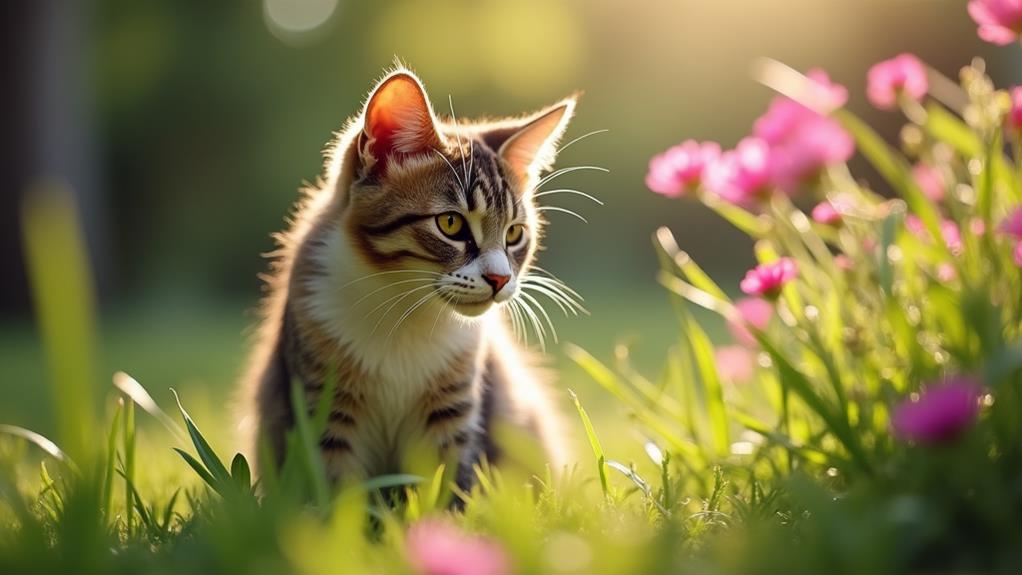What Is a Semi-Feral Cat? Understanding Their Behavior

A semi-feral cat is not fully wild but isn't domesticated either. Born outdoors and with limited human contact, they're often shy and cautious around unfamiliar people. You'll notice they have an intriguing mix of independence and curiosity, especially once they start recognizing familiar faces. These cats thrive within colonies, enjoying the social bond with other cats. Socialization requires patience; start by creating a safe, quiet space and gradually introducing interaction. Use treats to build trust and allow them to investigate at their own pace. If you're interested, there's much more to know about understanding and caring for these unique creatures.
Defining Semi-Feral Cats
Semi-feral cats are intriguing creatures that straddle the line between wild and domestic. Born outdoors, they've had limited human contact, making them naturally shy and somewhat fearful. Unlike fully feral cats, these semi-feral ones exhibit some social behaviors, showing curiosity towards humans they find familiar. Their progression from being wary of human interaction to potentially becoming loyal companions requires the dedication of patient caretakers.
If you've ever encountered semi-feral cats, you'll notice they often thrive in colonies, enjoying the companionship of other cats. They feel more at ease in an outdoor environment where they can maintain some distance while observing the world around them. When attempting to socialize these cats, gradual acclimatization to human contact is key. Rushing this process can cause stress, so it's essential to give them time to adjust to new surroundings and interactions.
These cats might not be the best fit for households with young children, given their sensitivity. However, with patience and understanding, they can slowly adapt to a more domestic lifestyle, forming bonds with those who respect their need for space and gradual shift from the wild.
Behavioral Traits
In understanding the behavioral traits of semi-feral cats, you'll notice they often exhibit a blend of independence and curiosity. Born in an outdoor home, these cats typically have limited human interaction, which shapes their shy and cautious demeanor. They're not immediately trusting of humans and can react fearfully when faced with unfamiliar people. This wariness is a result of their upbringing, where survival often takes precedence over socialization.
However, unlike their fully feral counterparts, semi-feral cats can show a hint of curiosity toward humans. This curiosity is a gateway to building a relationship based on trust. Patience and gentle human interaction are crucial to gradually socialize these cats, helping them adjust to human presence over time. They thrive in a colony setting, where the companionship of other cats provides comfort and social bonds.
In such environments, semi-feral cats often display a more social behavior among their feline peers, finding a sense of community and security. They aren't ideal for homes with young children due to their sensitivity and potential stress-induced fear responses. Understanding these traits can guide you in creating an environment where they feel safe and accepted.
Socialization Techniques

Understanding the unique behavioral traits of semi-feral cats sets the stage for effective socialization techniques. Start by confining them to a small, quiet space. This helps reduce stress and allows them to acclimate to their new environment. Establishing trust is essential, so make regular, non-threatening visits. Use a soft voice and gentle movements, providing basic care to help them feel safe. These actions encourage a semi-feral cat to become socialized over time.
Gradually introduce physical interaction on their terms. Let them approach you when they're ready, using treats to create positive associations with your presence. This method promotes positive interaction and helps build trust. Pay close attention to their body language; it's your guide to understanding their comfort level. Respect their boundaries and avoid overwhelming them to prevent setbacks.
As they grow more comfortable, slowly increase the duration of contact with humans and introduce them to other areas of your home. Always guarantee they have a safe retreat space available, offering a place to withdraw when they need some alone time. By following these techniques, you can help a semi-feral cat become more socialized and comfortable in their new environment.
Taming Challenges
In the domain of taming challenges, patience is your greatest ally. When working with semi-feral cats, keep in mind that each one possesses unique behavioral traits. Some might adapt more quickly to human interaction, while others remain cautious, requiring months or even years to build trust. Your approach should be gentle, allowing the cat to dictate the pace of interaction. Initially, ignoring them can pique their curiosity, letting them approach you on their own terms.
Understanding and respecting their boundaries is essential. Watch for stress signs, such as flattened ears or a twitching tail, as these indicate discomfort. Pushing them too quickly can lead to setbacks, so it's important to proceed with care.
Positive reinforcement is a powerful tool in this process. Use treats to create positive associations with your presence. Over time, this will encourage the cat to engage more readily. Consistent, gentle interaction is key to building trust. Keep in mind, taming a semi-feral cat is not a race; it's a process of mutual understanding and respect. By recognizing and adapting to their individual needs, you'll gradually foster a bond that, while challenging to achieve, is immensely rewarding.
Creating a Safe Space

As you work on building trust with a semi-feral cat, creating a safe space becomes a fundamental part of the process. Start by designating a quiet, secluded area in your home. This spot should have all the necessities: a litter box, food, and water. By keeping these resources close, you minimize the cat's stress and make it easier for them to adjust. Reducing anxiety is vital, so limit loud noises and chaotic activities in this space. This helps the semi-feral cat feel secure and encourages them to investigate more freely.
Incorporate hiding spots into this environment to give the cat a place to retreat when they feel overwhelmed or scared. Cardboard boxes or covered beds work well for this. To further improve the comfortable atmosphere, consider using calming aids like catnip or pheromone diffusers. These can help ease their adjustment into your home.
- Litter Box, Food, and Water: Keep these necessities in a quiet area to reduce stress.
- Hiding Spots: Provide safe retreats with boxes or covered beds.
- Calming Aids: Use catnip or pheromone diffusers to reduce anxiety.
Gradually allow them to investigate new areas at their own pace, ensuring they always have a secure retreat.
Long-Term Care Considerations
Caring for a semi-feral cat over the long term demands patience and consistency because the taming process varies greatly, often taking months or even years. Each cat's temperament and history influence how quickly they adjust to human interaction. Long-term care requires you to regularly monitor their behavior, looking for signs of stress or discomfort. This helps you adjust your approach to guarantee their well-being.
Creating a safe environment is fundamental for semi-feral cats. Provide them with hiding spots, interactive toys, and opportunities for exploration. These elements help them feel secure and keep their minds engaged. Regular veterinary check-ups are imperative. Semi-feral cats, often accustomed to outdoor living, might be prone to health issues, so these visits are crucial to address any emerging concerns.
Building trust with a semi-feral cat is a lifelong commitment. Focus on continuous socialization through positive interactions and gradually introduce them to different stimuli. This approach fosters a trusting relationship over time. Remember, every cat is unique, and the road to trust will vary. By being attentive to their needs, you create an environment where they can thrive and gradually become more comfortable with human companionship.




